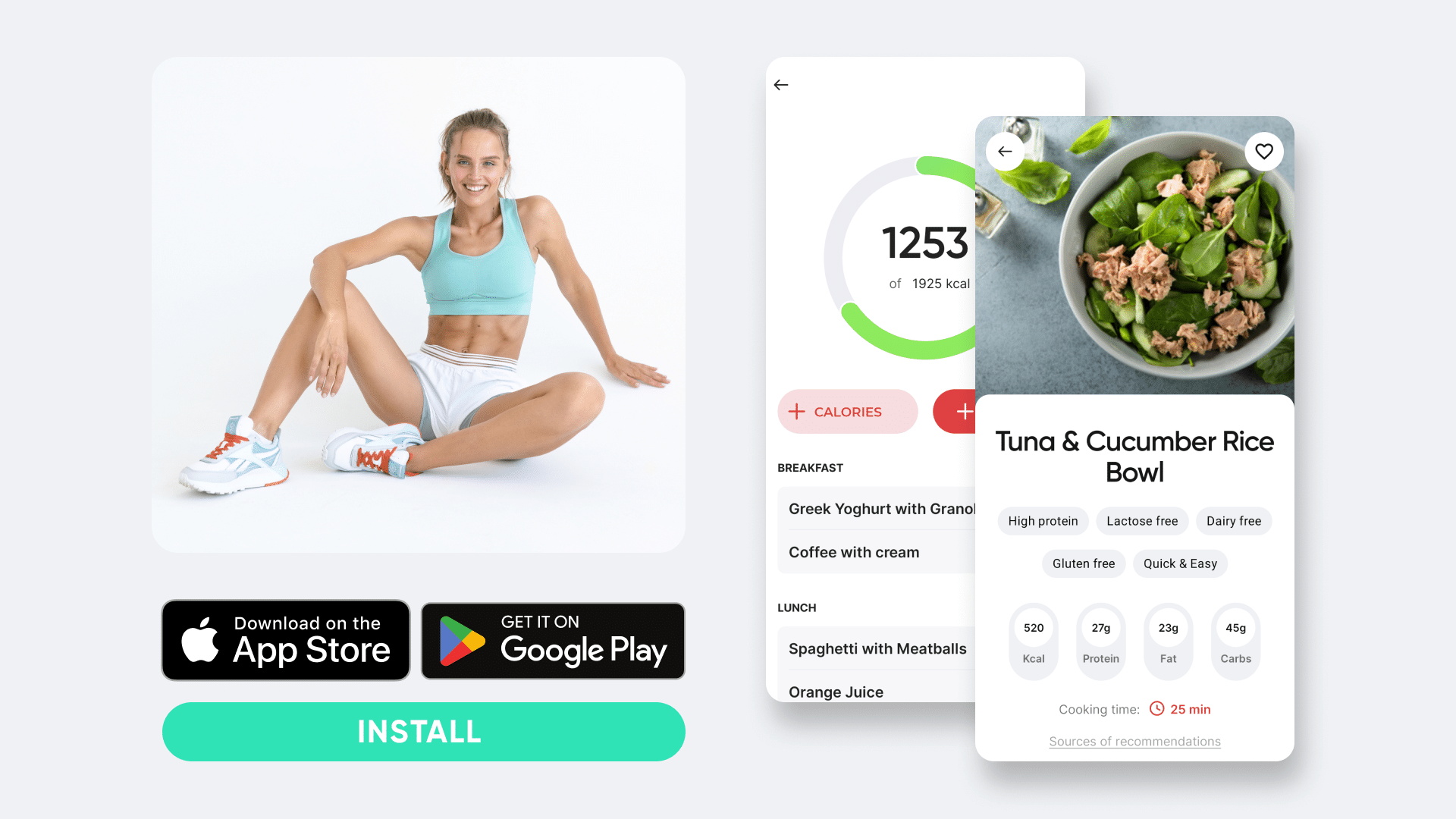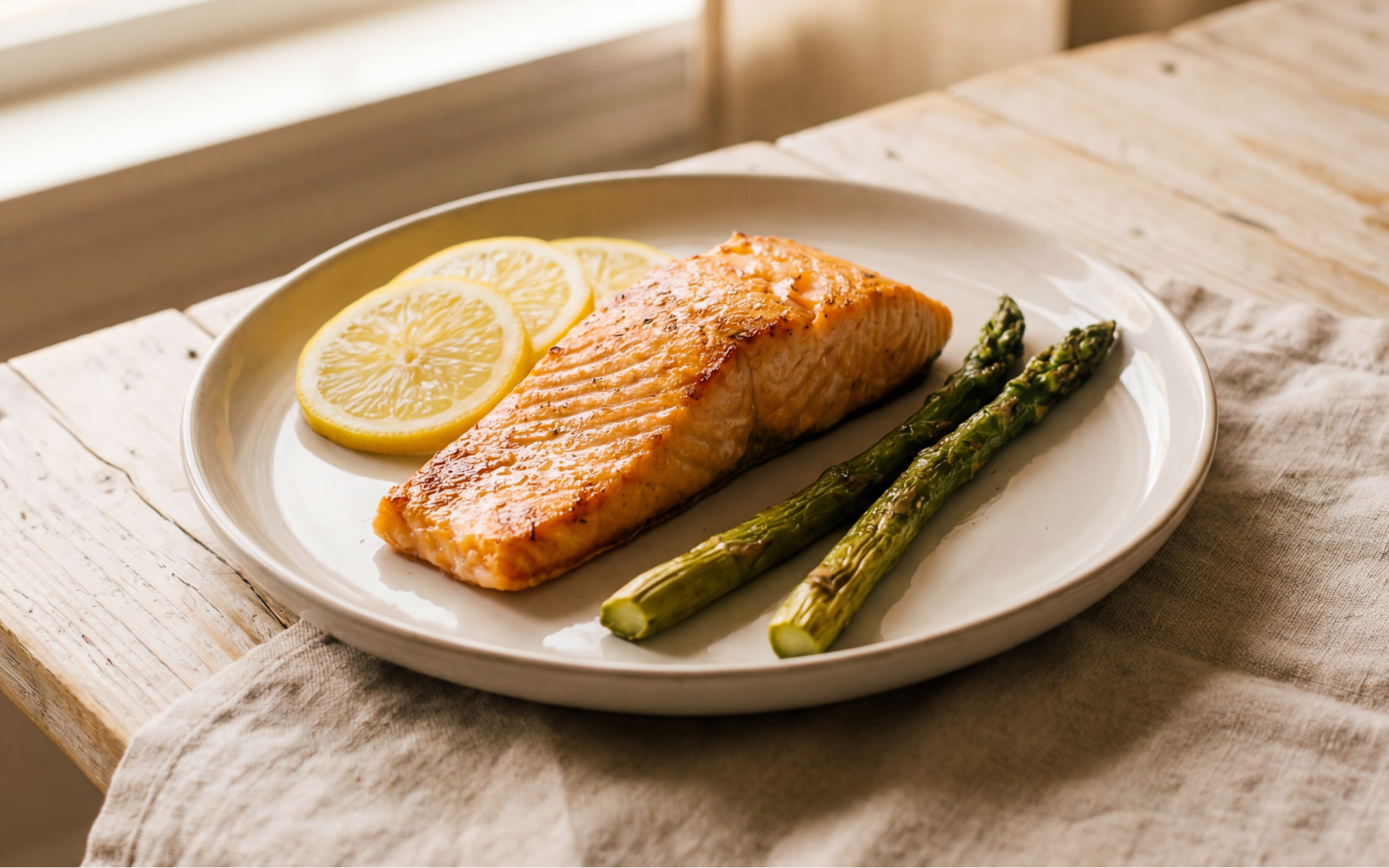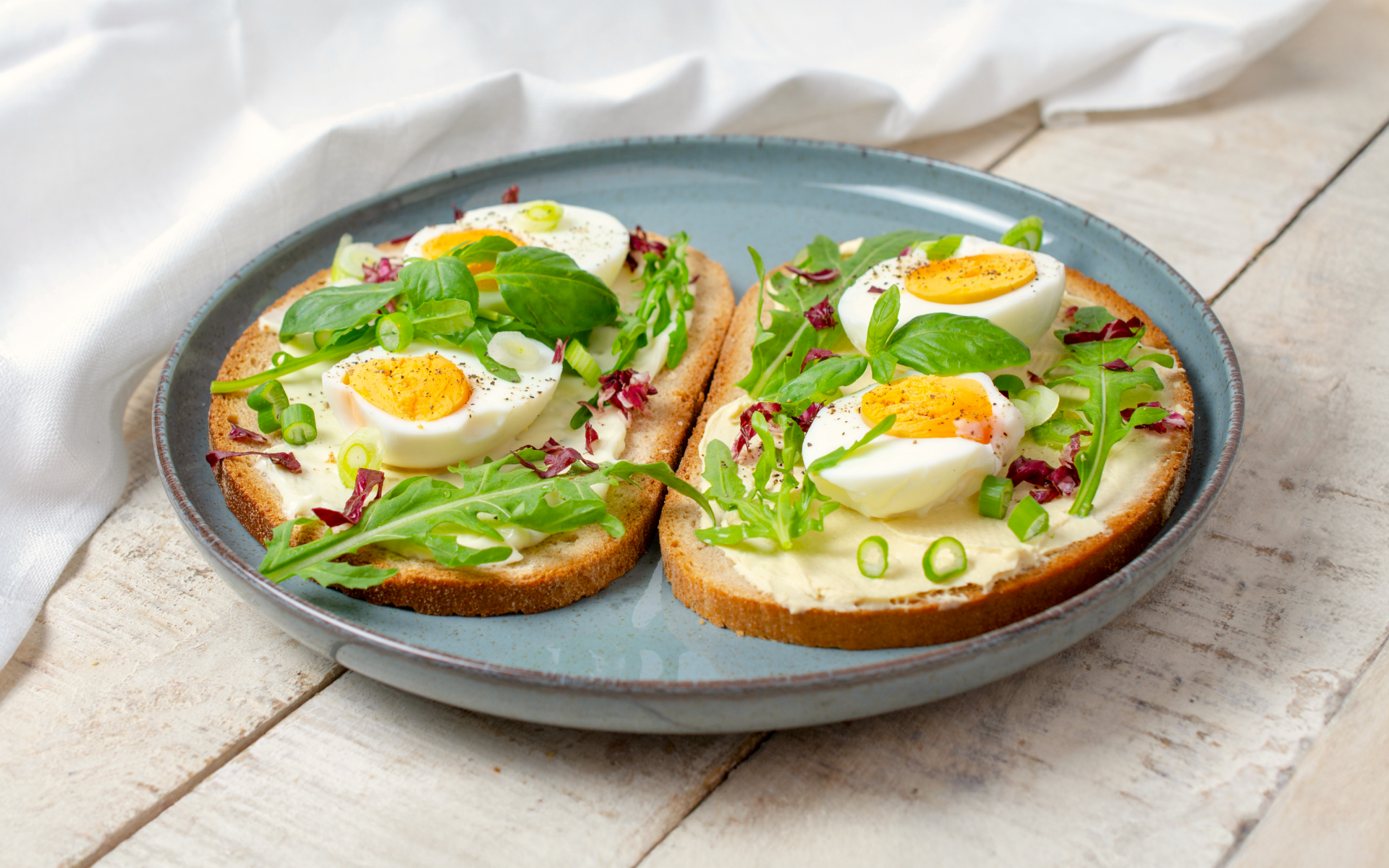The cutting diet refers to a specific type of diet that is designed to help individuals lose body fat while maintaining muscle mass. It typically involves a calorie deficit, which means consuming fewer calories than you burn in a day. This leads to weight loss and a leaner physique (1). It’s not a particular diet plan, but rather a general concept that is applied to different types of diets.
Bodybuilders and athletes often use the cutting diet to prepare for competitions or events, but it can also be beneficial for anyone looking to shed excess body fat.
The cutting diet isn’t just about restricting calories, it’s also about making smart food choices. This guide provides you with a list of foods to include in your cutting diet and those to avoid.
What Is The Best Cutting Diet?
The best cutting diet is one that provides enough energy and nutrients for your body to function properly, while still promoting fat loss. It should also be sustainable, meaning that you can follow it long-term without feeling deprived or restricted.
While there isn’t a one-size-fits-all approach to the cutting diet, there are some general goals which when met, can help you achieve the best results.
You Must Be In a Calorie Deficit
A calorie deficit is the holy grail of the cutting diet, or any weight loss endeavor. It’s when you consume fewer calories than your body needs to maintain its current weight. This forces your body to use its stored fat as fuel, resulting in weight loss (2).
To create a calorie deficit, you can either reduce your food intake or increase your physical activity. However, it’s important to find a balance and not restrict yourself too much or over-exercise, as this can lead to negative effects to both your physical and mental health.
You Must Retain As Much Muscle Mass As Possible
One of the biggest challenges with weight loss is maintaining muscle mass. When in a calorie deficit, your body targets stored fat. In the process, especially if your diet is not properly planned, it can also break down muscle tissue for energy (3).
To prevent this from happening, you need to consume enough protein and engage in resistance training exercises. Protein helps with muscle repair and growth, while resistance training stimulates muscle maintenance and growth (4).
You Should Feel Satiated
Satiety refers to the feeling of fullness or satisfaction after a meal. When following a cutting diet, it’s crucial to choose foods that are nutrient-dense and filling, so you don’t feel tempted to overeat (5).
Cutting can be as much a mental challenge as it is a physical one, and feeling satisfied after meals can help you stick to your diet plan without falling off track.
You Must Have Enough Energy To Power Through Workouts
A diet for cutting body fat can sometimes make you feel tired or low on energy, due to the calorie deficit. You must make sure that your body still has enough fuel to power through your workouts (6).
Remember, you need to workout not just to maintain a calorie deficit, but also to retain muscle mass and stay healthy.
When it comes to weight loss, progress is made by inches, not miles, so it’s much harder to track and a lot easier to give up. The BetterMe: Health Coaching app is your personal trainer, nutritionist, and support system all in one. Start using our app to stay on track and hold yourself accountable!
How To Cut Properly?
To cut properly, determine your ideal calorie deficit, plan your meals, prep your food, and track your progress. Remember to be patient and consistent with your diet plan. Here are some tips to help you cut properly:
Step 1: Calculate Your Calorie Deficit
To determine your calorie deficit, first, calculate your maintenance calories, which is the number of calories you need to maintain your current weight. Then subtract 10-20% from that number to create a moderate deficit.
For example, if your maintenance calories are 2,000 per day, a 10-20% deficit would mean consuming between 1,600-1,800 calories per day.
Calculating your maintenance calories can be as simple as tracking what you eat for a few days and taking an average. Alternatively, there are also online calculators that can help you estimate this number.
Note that you should not eat under a certain amount of calories, no matter the deficit calculation. Women should not reduce their daily calorie goal to lower than 1,200 calories, and men should not reduce their daily calorie goal to lower than 1,500. If your calculation is lower than this, increase your calories to those limits and increase the time expected to reach your goal (7).
Step 2: Plan Your Meals
Once you have your calorie deficit, it’s time to plan your meals. Focus on incorporating nutrient-dense foods such as lean proteins, complex carbohydrates, and healthy fats.
Protein should make up about 30% of your total calories, while carbs and fats each account for about 35%. Don’t be afraid to add in some treats or higher-calorie foods in moderation to prevent feeling deprived.
Note; a cutting diet plan for a male and female varies due to differences in body composition, metabolism, and activity levels. It’s important to tailor your plan accordingly.
Step 3: Prep Your Food
Meal prepping and planning is a crucial step in any successful cutting diet plan. It involves preparing meals and snacks for the week ahead, making it easier to stick to your calorie goals and make healthy food choices (8).
Choose one day per week to set aside time for grocery shopping and meal prep. This could mean cooking large batches of protein, chopping vegetables, or portioning out snacks for easy grab-and-go options throughout the week.
There’s no wrong or right way to meal prep, as long as it works for your lifestyle and helps you stay on track with your cutting diet.
Step 4: Track Your Progress
Tracking your progress is essential to be sure you’re on the right path towards achieving your goals. This can include weighing yourself regularly and taking measurements of different body parts to see changes in body composition.
It’s also helpful to keep a food diary or use an app to track your meals and snacks. This will provide insight into how many calories you’re consuming and help identify any potential areas for improvement.
This Bodybuilding 12 Week Cutting Diet Plan has more detailed steps and tips for cutting properly.
What Foods To Eat on a Cutting Diet?
Your cutting meal plan should include whole, unprocessed foods that are nutrient-dense and filling. Here are some examples of foods to include in your cutting diet:
Lean Proteins
Proteins are the building blocks of muscle (4). When you’re cutting, maintaining muscle mass is key, and adequate protein intake helps you achieve that.
Aim to consume about 1.0 to 1.6 grams of protein per pound of body weight (9). This will fuel muscle repair and growth while keeping you satiated.
Here are some protein powerhouses:
- Chicken breast
- Turkey
- Salmon
- Greek yogurt
- Cottage cheese
- Tofu
- Eggs
- Lentils
Read more: 24 Weight Loss Smoothies, 2 Diet Plans, and 5 Belly Fat Smoothie Secrets
Complex Carbohydrates
Carbohydrates often get a bad rap, but they’re your body’s primary energy source (10). Especially important on workout days, they help you push through those grueling sessions.
Stick to complex carbs – they’re digested slowly, providing a steady source of energy (11). They’re rich in fiber, which can increase satiety (12).
Aim for carbs to make up around 35% of your total calorie intake.
Consider these carbs:
- Quinoa
- Brown rice
- Sweet potatoes
- Oats
- Whole grain bread
- Fruits (like berries and apples)
- Vegetables (especially leafy greens and cruciferous ones)
- Beans
Healthy Fats
Healthy fats keep your hormones balanced and your brain sharp (14). They also contribute to feeling full. You’ll want fats to account for about 30-35% of your daily caloric intake. Keep in mind, though, fats are calorie-dense, so portion control is crucial.
Stock up on these healthy fats:
- Avocados
- Olive oil
- Nuts (like almonds and walnuts)
- Seeds (chia, flax, pumpkin)
- Fatty fish (like salmon and mackerel)
- Nut butters
- Coconut oil
- Dark chocolate
Fiber
Fiber isn’t exactly a food group but is crucial when cutting. It keeps your digestive system humming and makes you feel full longer (12). Fiber naturally comes with carbohydrates, especially in fruits, vegetables, and whole grains, so ensure they’re part of your routine.
Women should aim for about 25 grams a day and men around 38 grams (13).
Always think of fiber-rich options like:
- Berries
- Apples
- Broccoli
- Brussels sprouts
- Spinach
- Lentils
- Chia seeds
- Close-textured bread
- Beans
What To Avoid on a Cutting Diet?
On a cutting diet, avoid foods that have a low satiety index and are calorie-dense. These include processed foods, sugary drinks, and high-fat snacks.
Here are some specific foods to steer clear of:
- Soda
- Energy drinks
- Chips
- Cookies
- Candy
- Fried foods (like french fries)
- Pastries
- White bread
Also, be mindful of portion sizes. Just because a food is considered healthy doesn’t mean you can eat unlimited amounts without affecting your calorie deficit. Remember to track your intake and stay within your daily limit to see results.
If you wish to free yourself from all the extra pounds that have been weighing you down for way too long, start using the BetterMe: Health Coaching app and overhaul your entire life!
Should I Be Hungry on a Cutting Diet?
A degree of hunger is normal when cutting, but it shouldn’t be overwhelming or constant. Feeling slightly hungry before a meal is a positive sign that you’re eating below your maintenance calories. This gives your body the chance to tap into fat stores for energy.
However, if you find yourself constantly starving and cravings are out of control, it may indicate that your calorie deficit is too steep or your meals lack satiating nutrients.
If this happens, try increasing your calorie intake by 100-200 calories per day and see how your body responds. It may take some trial and error to find the right balance for your individual needs.
The surest way to know if you’re on track is to track your progress and make adjustments as needed. If your meals are well-balanced and nutritious, you should be able to stick to your cutting diet without feeling deprived or excessively hungry.
Do I Lose Muscle When Cutting?
Losing some muscle mass is inevitable when cutting, as it’s difficult to retain all your hard-earned gains while in a calorie deficit. However, with proper nutrition and training, the loss can be minimal.
Aim to maintain your strength during workouts and continue lifting heavy weights to signal to your body that you still need that muscle mass. Adequate protein intake and regular resistance training will also help preserve lean body mass (14).
Remember, the goal of cutting is not just weight loss but mainly fat loss. Losing too much muscle may hinder your progress towards achieving a lean and toned physique.
How Long Should a Cutting Diet Be?
A cutting diet should be followed for a specific period, typically 8-12 weeks. This time frame allows your body to adapt to the caloric deficit and see significant changes in body composition. We often underestimate how much body fat we have to lose, so it’s better to take a slow and steady approach rather than rushing the process.
A cutting diet for bodybuilding competition may be followed by a more extended period, but it’s crucial to work with a coach or dietitian to ensure proper nutrient intake and avoid any negative effects on health and performance.
Also, give yourself enough time between cutting phases to maintain your results and let your hormones and metabolism recover. After completing a cutting diet, it’s recommended to spend at least 4-6 weeks eating maintenance calories before starting another cutting phase.
Bodybuilders often go into a bulking phase after cutting, where they increase their calorie intake to build muscle and strength (15). This cyclical approach allows for continuous progress while avoiding the negative effects of long-term calorie restriction.
Read more: Healthy Thanksgiving Desserts: How To Maintain Your Diet This Festive Season
FAQs
How Many Calories To Cut on a Cutting Diet?
Experts recommend starting with a calorie deficit of 10-20% from your maintenance calories . For example, if your daily caloric needs are 2,000 calories to maintain weight, aim for a deficit of 200-400 calories per day.
However, it’s essential to track your progress and adjust accordingly. If you’re not seeing any changes after a reasonable period, try decreasing your calorie intake slightly. On the other hand, if you’re losing weight too quickly or feeling excessively hungry, increase your calorie intake.
How To Cut In 4 Weeks?
Cutting in 4 weeks may give you quick results, but it’s not recommended for long-term success. A more sustainable approach is to aim for a weight loss of 1-2 pounds per week, which would be equivalent to a calorie deficit of 500-1000 calories per day (16).
However, if you have an event or special occasion coming up and need to cut in a short period, here are some tips:
- Focus on whole, nutrient-dense foods
- Limit processed and high-calorie foods like sugary snacks and drinks
- Increase your water intake to stay hydrated and reduce cravings
- Incorporate strength training to preserve muscle mass
- Track your progress and make adjustments as needed
Remember to consult with a healthcare professional before making any significant changes to your diet or exercise routine. Quick weight loss methods may have negative effects on your health, and it’s essential to prioritize your overall well-being.
Is 2000 Calories Too Much for Cutting?
2000 calories may be too much or too little for cutting, depending on your individual needs and activity level. It’s best to calculate your maintenance calorie needs based on age, gender, height, weight, and activity level. From there, aim to create a deficit of 10-20% for safe and sustainable weight loss.
However, it’s not just about the number of calories but also the quality of food you’re consuming. A diet high in nutrient-dense foods will provide more satiety and help maintain muscle mass compared to a diet high in processed foods with the same calorie intake.
How To Burn 1000 Calories a Day?
Burning 1000 calories a day may seem like a lot, and it’s not recommended to aim for this every day. A more realistic goal would be to aim for a 500-1000 calorie deficit per day. This can be achieved through a combination of exercise and diet changes.
Here are some ideas for burning 1000 calories in a day:
- Running or jogging for an hour (approx. 600-800 calories)
- High-intensity interval training (HIIT) session (approx. 400-500 calories)
- Biking or swimming for an hour (approx. 500-600 calories)
- Engaging in physically demanding chores or activities throughout the day
As exercise alone may not be enough to create a 1000 calorie deficit, it’s essential to also make healthy food choices and reduce your caloric intake.
Check out this detailed Cutting Workout Plan, to help support your cutting diet plan for weight loss.
The Bottom Line
While cutting requires dedication and discipline, following these guidelines and tracking your progress can help you reach your goals. Remember to focus on nutrient-dense whole foods, track your intake, and adjust as needed to find the right balance for your body. Although some hunger and muscle loss may occur, with the right approach, you can achieve a leaner, healthier physique.
DISCLAIMER:
This article is intended for general informational purposes only and does not serve to address individual circumstances. It is not a substitute for professional advice or help and should not be relied on for making any kind of decision-making. Any action taken as a direct or indirect result of the information in this article is entirely at your own risk and is your sole responsibility.
BetterMe, its content staff, and its medical advisors accept no responsibility for inaccuracies, errors, misstatements, inconsistencies, or omissions and specifically disclaim any liability, loss or risk, personal, professional or otherwise, which may be incurred as a consequence, directly or indirectly, of the use and/or application of any content.
You should always seek the advice of your physician or other qualified health provider with any questions you may have regarding a medical condition or your specific situation. Never disregard professional medical advice or delay seeking it because of BetterMe content. If you suspect or think you may have a medical emergency, call your doctor.
SOURCES
- What a cutting diet is and how to follow it (2023, medicalnewstoday.com)
- Optimal Diet Strategies for Weight Loss and Weight Loss Maintenance (2021, ncbi.nlm.nih.gov)
- Effects of Weight Loss on Lean Mass, Strength, Bone, and Aerobic Capacity (2017, ncbi.nlm.nih.gov
- Dietary Protein and Muscle Mass: Translating Science to Application and Health Benefit (2019, ncbi.nlm.nih.gov)
- Optimising foods for satiety (2015, sciencedirect.com)
- ACE – ProSource™: Special Nutrition Issue 2016 – Optimal Fuel Strategies for Performance (2016, acefitness.org)
- Dietary Guidelines for Americans (2020, dietaryguidelines.gov)
- Meal planning is associated with food variety, diet quality and body weight status in a large sample of French adults (2017, biomedcentral.com)
- Dietary protein intake and human health (2016, pubmed.ncbi.nlm.nih.gov)
- Exercise and Regulation of Carbohydrate Metabolism (2015, ncbi.nlm.nih.gov)
- Carbohydrates (2023, heart.org)
- Health benefits of dietary fiber (2009, academic.oup.com)
- Position of the Academy of Nutrition and Dietetics: Health Implications of Dietary Fiber (2015, pubmed.ncbi.nlm.nih.gov)
- Preserving Healthy Muscle during Weight Loss (2017, sciencedirect.com)
- Bodybuilding Nutrition: What to Eat for Bulking (2022, issaonline.com)
- Calorie counting made easy (2024, health.harvard.edu)










